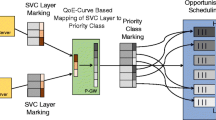Abstract
Wang et al. propose the cross layer resource allocation algorithm considering channel state information in layer 1 and rate-distortion function in layer 5, for uplink convolutional coded OFDMA video transmission systems. In this paper, we propose the use of hybrid automatic repeat request protocol (HARQ) and the turbo code to improve Peak-Signal-to-Noise Ratio (PSNR, the measure of the video quality). We define this HARQ overhead consumption and adjust PSNR for HARQ redundancy. The simulation results show that, for the HARQ redundancy adjusted PSNR, the proposed turbo-coded HARQ scheme outperforms the proposed convolutional coded HARQ scheme and the convolutional coded no HARQ scheme in Wang et al. by 3.25, and 3.95 dB, respectively, when maximum two retransmissions are allowed for HARQ. The proposed turbo-coded HARQ scheme achieved maximum HARQ redundancy adjusted PSNR for just 2 retransmissions allowed; while the proposed convolutional coded HARQ scheme achieve maximum (but still lower than the proposed turbo-coded HARQ scheme) for 4 retransmissions allowed. Thus the proposed turbo-coded HARQ scheme has smaller delay than the proposed convolutional coded HARQ scheme.






Similar content being viewed by others
References
Berrou, C., & Glavieux, A. (1996). Near optimum error correcting coding and decoding: Turbo-codes. IEEE Transactions on Communications, 44(10), 1261–1271.
Chen, Z., & Ngan, K. N. (2007). Recent advances in rate control for video coding. Signal Processing: Image Communication, 22(1), 19–38.
Chen, Y. F., Lee, Y. H., & Hwang, P. T. (2011). Adaptive channel estimation for multiple antenna OFDM systems. Wireless Personal Communications, 59(2), 331–343.
Heegard, C., & Wicker, S. B. (1999). Turbo coding (pp. 55–57). Berlin: Springer.
Cook, G., Prades-Nebot, J., Liu, Y., & Delp, E. (2006). Rate-distortion analysis of motion-compensated rate scalable video. IEEE Transactions on Image Processing, 15(8), 2170–2190.
Goldsmith, A. (2005). Wireless communications. Cambridge: Cambridge University Press.
Ksairi, N., Ciblat, P., & Le Martret, C. J. (2014). Near-optimal resource allocation for type-II HARQ based ofdma networks under rate and power constraints. IEEE Transactions on Wireless Communications, 13(10), 5621–5634.
Lee, J. C., & Lee, M. H. (2013). Sub-channel allocation based on multi-level priority in OFDMA systems. KSII Transactions on Internet and Information Systems, 7(8), 1876–1889.
Lee, K.-C., Wang, S.-H., Li, C.-P., Chang, H.-H., & Li, H.-J. (2014). Adaptive resource allocation algorithm based on cross-entropy method for OFDMA systems. IEEE Transactions on Broadcasting, 60, 524–531.
Liu, Y., Ma, Q. & Zhang, H. (2009). Power allocation and adaptive modulation for OFDM systems with imperfect CSI. In Proceedings of vehicular technology conference, 2009. VTC Spring 2009. IEEE 69th (pp. 1–4).
Liu, D., Cui, H., & Luo, C. (2016). Resource allocation for uncoded multi-user video transmission over wireless networks. Mob Netw Appl, 21, 950–961.
Maham, B., Jedari, E. & Enayati,A. (2007). Adaptive rate and power allocation schemes for OFDM/SDMA system. In Proceedings of second international conference on communications and networking in China (pp. 534–538).
Malkamaki, E., & Leib, H. (2000). Performance of truncated type-II hybrid ARQ schemes with noisy feedback over block fading channels. IEEE Transactions on Wireless Communications, 48(9), 1477–1487.
Marcille, S., Ciblat, P. & Le Martret, C. J. (2013). Resource allocation for Type-I HARQ-based wireless networks with finite-length codes. In Proceedings of IEEE workshop on signal processing advances in wireless communications (SPAWC) (pp. 1–5).
Ortega, A., Ramchandran, K., & Vetterli, M. (1994). Optimal trellis-based buffered compression and fast approximations. IEEE Transactions on Image Processing, 3(1), 26–40.
Pao, W. C., & Chen, Y. F. (2014). Adaptive gradient-based methods for adaptive power allocation in OFDM-based cognitive radio networks. IEEE Transactions on Vehicular Technology, 63(2), 836–848.
Proakis, J. G. (2000). Digitial communications. New York: McGraw Hill Higher Education.
Stuhlmuller, K., Farber, N., Link, M., & Girod, B. (2000). Analysis of video transmission over lossy channels. IEEE Journal on Selected Areas in Communications, 18(6), 1012–1032.
Wang, D., Toni, L., Cosman, P. C., & Milstein, L. B. (2013). Uplink resource management for multiuser OFDM video transmission systems: Analysis and algorithm design. IEEE Transactions on Communications, 61(5), 2060–2073.
Part 11: Wireless LAN medium access control (MAC) and physical layer (PHY) specifications, IEEE Standard 802.11™, 2012.
Wong, C. Y., Cheng, R. S., Lataief, K. B., & Murch, R. D. (1999). Multiuser OFDM with adaptive subcarrier, bit, and power allocation. IEEE Journal on Selected Areas in Communications, 17(10), 1747–1758.
Wong, I. C., & Evans, B. L. (2009). Optimal resource allocation in the OFDMA downlink with imperfect channel knowledge. IEEE Transactions on Communications, 57(1), 232–241.
Wang, Z., Liu, L., Wang, X., & Zhang, J. (2014). Resource allocation in OFDMA networks with imperfect channel state information. IEEE Communications Letters, 18(9), 1611–1614.
Acknowledgements
This work was presented in part at 2016 International Symposium on Electrical, Electronic Engineering and Digital Technology (SEDT). Tokyo, Japan. The work was supported in part by Ministry of Science and Technology, Taiwan, under Grant MOST 105-2221-E-027-007.
Author information
Authors and Affiliations
Corresponding author
Rights and permissions
About this article
Cite this article
Chen, YF., Tseng, SM., Shen, CH. et al. Cross Layer 1, 2 and 5 Resource Allocation in Uplink Turbo-coded HARQ Based OFDMA Video Transmission Systems. Wireless Pers Commun 98, 1997–2008 (2018). https://doi.org/10.1007/s11277-017-4959-8
Published:
Issue Date:
DOI: https://doi.org/10.1007/s11277-017-4959-8




